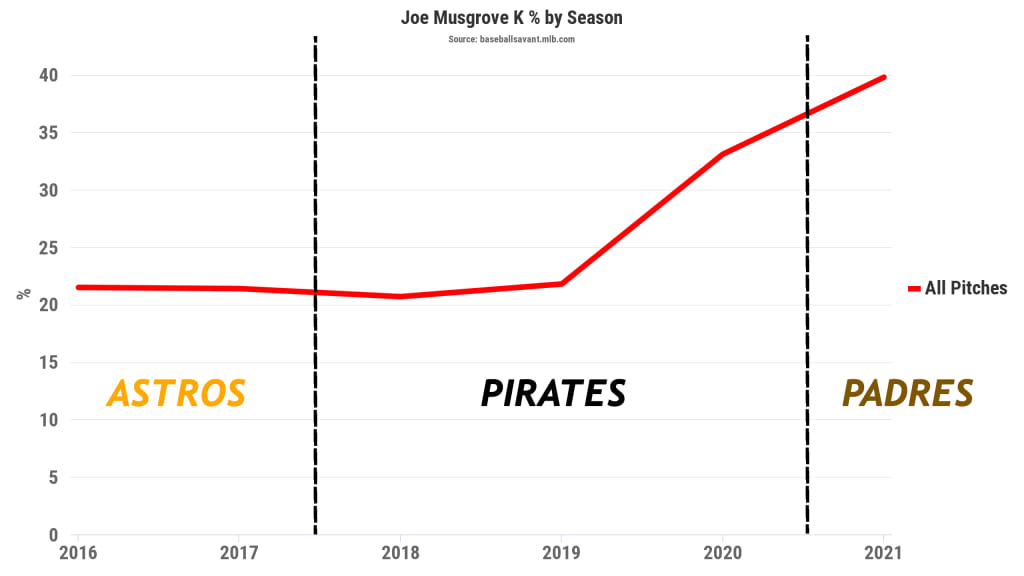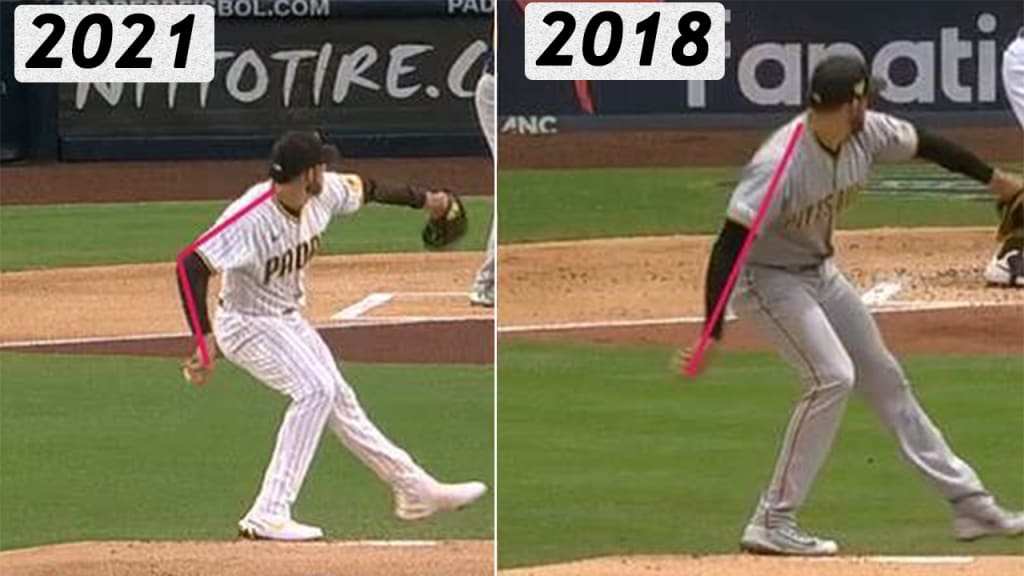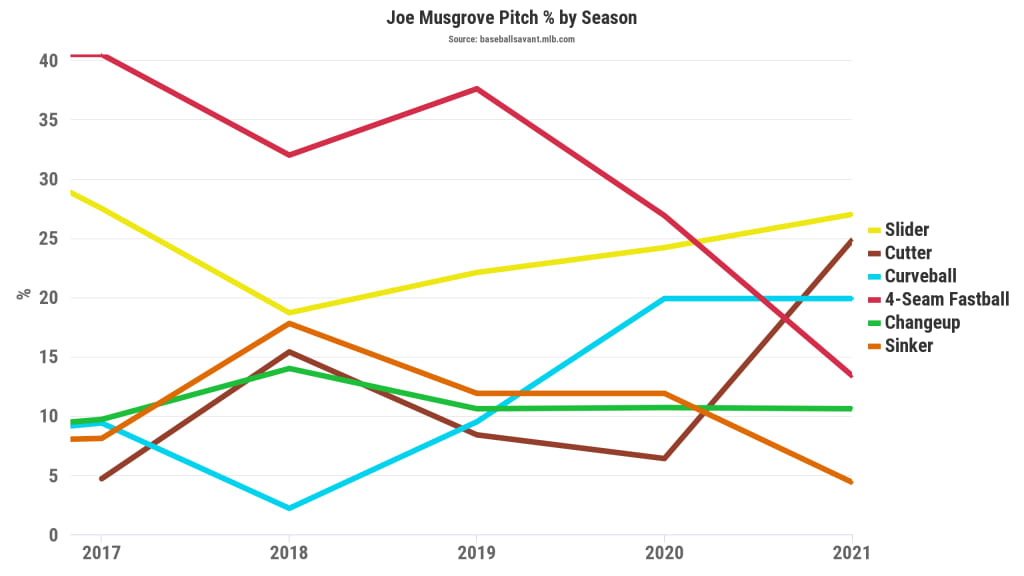We now join the Joe Musgrove breakout, already in progress.
It’s that last part -- already in progress -- that’s important here, because otherwise it’s a little too easy to lump Musgrove into the growing collection of ex-Pirates starters who blossomed upon leaving Pittsburgh, like Charlie Morton, Gerrit Cole, Tyler Glasnow and now Musgrove.
Maybe the Pirates have earned that unfortunate distinction, but this is different. Musgrove, who starts against Dustin May and the Dodgers on Sunday Night Baseball (7 p.m. ET on ESPN, with a special Statcast-specific alternate broadcast on ESPN2) already had plenty of signs of a breakout in 2020. If you were looking closely enough, you could see it at the end of 2019, really. Don't worry, Pirates fans; this is a success story.
We’re not just saying that in retrospect, either. Clearly, Musgrove has made some changes with San Diego that have fueled his ascent to the top level of starting pitchers, but there was already a lot to like about him before the trade. Here, for example, is a FanGraphs article from February 2020 singing his praises. Here’s an article MLB.com’s Thomas Harrigan wrote in January, originally before the trade, that said the same.
So sure, Musgrove has been fantastic, throwing the first no-hitter in Padres history, allowing three earned runs in four games, with a 39.8% strikeout rate that was the seventh best in baseball entering Friday, and sure, some of that is due to what he’s now doing differently. Not all of it, though. Here’s what he’s doing now … and how he got here.
The breakout began in 2019
We’re going to set a cutoff date of right after the Aug. 21, 2019, outing in which Musgrove allowed six runs in five innings in an 11-1 loss to Washington, the third time in his previous six starts he’d allowed five or more runs. That game marked the 95th of Musgrove’s career, including time he’d spent in Houston before coming to Pittsburgh as part of the Cole trade.
Let’s split those 95 games from the remaining 13 of his Pirates career, spanning the remainder of 2019 and all of 2020, before the trade to San Diego.
First 95 games: 4.47 ERA, 20.9% strikeout rate, .749 OPS
Next 13 games: 3.46 ERA, 31% strikeout rate, .683 OPS
That’s pretty noticeable, right? Remember; to this point, we’re not counting his time as a Padre in 2021 at all. You can pretty clearly see the strikeout rate, which had been very stable (and not terribly impressive) for his first four years, rise while still with Pittsburgh.

So what’s that about? And why did we split it after that particular August game? Because sometimes, pitchers make it easy on us by detailing exactly what they’ve done. In Musgrove’s case, it started with a delivery change, one inspired by watching Cleveland ace Shane Bieber on television, meant to conceal the ball from hitters more by using a shorter arm action, similar to what Lucas Giolito has done.
“I tried it, and it worked out well,” Musgrove told the Pittsburgh Post-Gazette in February 2020. “Keeping a 90-degree angle, the ball hidden behind my body, it cleaned up the arm path. It made my breaking ball better. The spin on my fastball got better. The arm recovery got better. It helped me in a lot of different areas, but I wasn’t sure why it was helping me.”
It’s not hard to see the difference.

But note what he said about his fastball getting better. The velocity through Aug. 21? 92.4 mph. The velocity in the remaining starts? 94.3 mph. His swing-and-miss rate, overall, doubled. Or, as Ben Clemens wrote at FanGraphs before 2020: “For his career, Musgrove has a strikeout rate more than 2% higher when he averages above 94 mph for an appearance than when he averages below."
Throwing harder and having the batter have a tougher time seeing it? That's a huge deal, and the results were immediate.
The Bieber connection
Bieber is either the best pitcher in the baseball or at least in the top three, depending on how you feel about Corbin Burnes or Jacob deGrom on any given day, so it’s interesting that we keep finding all of these connections between him and Musgrove.
As we noted above, Musgrove was interested in changing his delivery to be something nearer to Bieber’s -- mission accomplished -- and when we introduced Statcast’s ability to measure pitch spin directly this past winter, look who showed up on a list together.
What that is saying -- and please read it more fully here -- is that last year, Bieber and Musgrove were two of the only four pitchers in baseball to share a particular set of pitch spin characteristics. Their fastballs and curveballs mirrored one another perfectly, and their sliders and curveballs spun in the same direction. (And while Alec Mills might not be as big a name, don’t forget he did throw a no-hitter while mostly averaging a mere 90 mph on his fastball.)
We’ve never really been able to quantify “deception,” but between hiding the ball better and spinning it in ways that are difficult for a hitter to identify, this seems to be on that track. So what Musgrove did may have been hard work, but the outcomes were simple: He started throwing harder, and it was more difficult for batters to see what was coming in the first place.
But wait, there’s more. Last year, there were 13 specific pitches -- pitcher and pitch type -- that had a swing-and-miss rate north of 50%, at least among those from starters that induced at least 25 swings. We’re talking big names, like Tyler Glasnow’s curve, or the sliders of Max Scherzer and Giolito. Only two pitchers managed to get two pitches on the list. One was Bieber, thanks to his slider and his changeup. The other was Musgrove, who did it with his curveball and slider.
New home, new pitches
That doesn’t mean he’s not doing anything differently, of course. Harrigan, in January, noted that Musgrove’s four-seamer was an issue. “Musgrove's four-seam fastball,” wrote Harrigan, “which sits between 92-93 mph, has been at the root of his inconsistency during his five-year career.”
That’s true. In 2020, he allowed a .676 slugging percentage on it. Things don’t usually work out this cleanly, but if you look at what Musgrove is throwing in 2021 …

… right. The four-seamer is mostly gone. The cutter is in. But what’s more interesting is that for the first time, his primary pitch is now a slider, which he’s throwing nearly 30% of a time. It's been fantastic.
Musgrove's slider is legitimately one of baseball's best pitches
He's thrown it 99 times and allowed all of one hit, which should tell you a lot about it, but also just look at this thing.
If that looks impressive, that's because it is. Only a handful of pitchers have more horizontal movement on their slider than Musgrove does (he gets 9.4 more inches than other sliders at his velocity), and only two of those -- Sonny Gray and Shohei Ohtani -- are from starting pitchers. In terms of pitch value, "throwing it 99 times and allowing a single hit while striking out 22" gets you into the most elite group in the game, up there with Glasnow's curveball and Burnes' cutter.
Though Musgrove is still only 28, he's been around for a while, having been drafted way back in 2011 by the Blue Jays as the 46th overall pick out of Grossmont High School in El Cajon, Calif. It took him five years to get to the Majors, and four more after that to ascend from "competent" to "very good," and now, a decade later, he looks great. Generally, you wouldn't put more emphasis on four April starts than on years of evaluation, but this is different. The changes are real, and they didn't just happen this year. This is a breakout that's been a long time coming.
